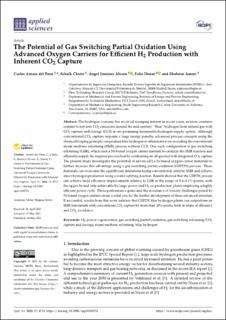| dc.contributor.author | del Pozo, Carlos Arnaiz | |
| dc.contributor.author | Cloete, Schalk Willem Petrus | |
| dc.contributor.author | Álvaro, Ángel Jiménez | |
| dc.contributor.author | Donat, Felix | |
| dc.contributor.author | Amini, Shahriar | |
| dc.date.accessioned | 2022-03-23T14:43:36Z | |
| dc.date.available | 2022-03-23T14:43:36Z | |
| dc.date.created | 2022-01-12T06:32:31Z | |
| dc.date.issued | 2021 | |
| dc.identifier.citation | Applied Sciences. 2021, 11 (10), . | en_US |
| dc.identifier.issn | 2076-3417 | |
| dc.identifier.uri | https://hdl.handle.net/11250/2987149 | |
| dc.description.abstract | The hydrogen economy has received resurging interest in recent years, as more countries commit to net-zero CO2 emissions around the mid-century. “Blue” hydrogen from natural gas with CO2 capture and storage (CCS) is one promising sustainable hydrogen supply option. Although conventional CO2 capture imposes a large energy penalty, advanced process concepts using the chemical looping principle can produce blue hydrogen at efficiencies even exceeding the conventional steam methane reforming (SMR) process without CCS. One such configuration is gas switching reforming (GSR), which uses a Ni-based oxygen carrier material to catalyze the SMR reaction and efficiently supply the required process heat by combusting an off-gas fuel with integrated CO2 capture. The present study investigates the potential of advanced La-Fe-based oxygen carrier materials to further increase this advantage using a gas switching partial oxidation (GSPOX) process. These materials can overcome the equilibrium limitations facing conventional catalytic SMR and achieve direct hydrogen production using a water-splitting reaction. Results showed that the GSPOX process can achieve mild efficiency improvements relative to GSR in the range of 0.6–4.1%-points, with the upper bound only achievable by large power and H2 co-production plants employing a highly efficient power cycle. These performance gains and the avoidance of toxicity challenges posed by Ni-based oxygen carriers create a solid case for the further development of these advanced materials. If successful, results from this work indicate that GSPOX blue hydrogen plants can outperform an SMR benchmark with conventional CO2 capture by more than 10%-points, both in terms of efficiency and CO2 avoidance. | en_US |
| dc.language.iso | eng | en_US |
| dc.publisher | MDPI | en_US |
| dc.rights | Navngivelse 4.0 Internasjonal | * |
| dc.rights.uri | http://creativecommons.org/licenses/by/4.0/deed.no | * |
| dc.subject | blue hydrogen | en_US |
| dc.subject | steam methane reforming | en_US |
| dc.subject | CO2 capture and storage | en_US |
| dc.subject | gas switching reforming | en_US |
| dc.subject | gas switching partial oxidation | en_US |
| dc.subject | H2-power cogeneration | en_US |
| dc.title | The Potential of Gas Switching Partial Oxidation Using Advanced Oxygen Carriers for Efficient H2 Production with Inherent CO2 Capture | en_US |
| dc.type | Peer reviewed | en_US |
| dc.type | Journal article | en_US |
| dc.description.version | publishedVersion | en_US |
| dc.rights.holder | Copyright: © 2021 by the authors. Licensee MDPI, Basel, Switzerland. This article is an open access article distributed under the terms and conditions of the Creative Commons Attribution (CC BY) license (https:// creativecommons.org/licenses/by/ 4.0/). | en_US |
| dc.source.pagenumber | 35 | en_US |
| dc.source.volume | 11 | en_US |
| dc.source.journal | Applied Sciences | en_US |
| dc.source.issue | 10 | en_US |
| dc.identifier.doi | 10.3390/app11104713 | |
| dc.identifier.cristin | 1978964 | |
| dc.source.articlenumber | 4713 | en_US |
| cristin.ispublished | true | |
| cristin.fulltext | original | |
| cristin.qualitycode | 1 | |

